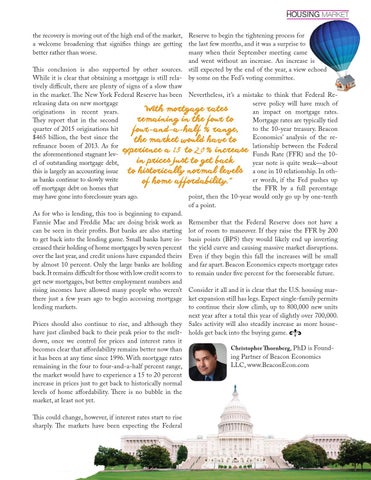HOUSING MARKET the recovery is moving out of the high end of the market, Reserve to begin the tightening process for a welcome broadening that signifies things are getting the last few months, and it was a surprise to better rather than worse. many when their September meeting came and went without an increase. An increase is This conclusion is also supported by other sources. still expected by the end of the year, a view echoed While it is clear that obtaining a mortgage is still rela- by some on the Fed’s voting committee. tively difficult, there are plenty of signs of a slow thaw in the market. The New York Federal Reserve has been Nevertheless, it’s a mistake to think that Federal Rereleasing data on new mortgage serve policy will have much of “With mortgage rates originations in recent years. an impact on mortgage rates. remaining in the four to They report that in the second Mortgage rates are typically tied quarter of 2015 originations hit to the 10-year treasury. Beacon four-and-a-half % range, $465 billion, the best since the Economics’ analysis of the rethe market would have to refinance boom of 2013. As for lationship between the Federal experience a to % increase Funds Rate (FFR) and the 10the aforementioned stagnant levin prices just to get back el of outstanding mortgage debt, year note is quite weak—about this is largely an accounting issue to historically normal levels a one in 10 relationship. In othas banks continue to slowly write er words, if the Fed pushes up of home affordability.” off mortgage debt on homes that the FFR by a full percentage may have gone into foreclosure years ago. point, then the 10-year would only go up by one-tenth of a point. As for who is lending, this too is beginning to expand. Fannie Mae and Freddie Mac are doing brisk work as Remember that the Federal Reserve does not have a can be seen in their profits. But banks are also starting lot of room to maneuver. If they raise the FFR by 200 to get back into the lending game. Small banks have in- basis points (BPS) they would likely end up inverting creased their holding of home mortgages by seven percent the yield curve and causing massive market disruptions. over the last year, and credit unions have expanded theirs Even if they begin this fall the increases will be small by almost 10 percent. Only the large banks are holding and far apart. Beacon Economics expects mortgage rates back. It remains difficult for those with low credit scores to to remain under five percent for the foreseeable future. get new mortgages, but better employment numbers and rising incomes have allowed many people who weren’t Consider it all and it is clear that the U.S. housing marthere just a few years ago to begin accessing mortgage ket expansion still has legs. Expect single-family permits lending markets. to continue their slow climb, up to 800,000 new units next year after a total this year of slightly over 700,000. Prices should also continue to rise, and although they Sales activity will also steadily increase as more househave just climbed back to their peak prior to the melt- holds get back into the buying game. down, once we control for prices and interest rates it Christopher Thornberg, PhD is Foundbecomes clear that affordability remains better now than ing Partner of Beacon Economics it has been at any time since 1996. With mortgage rates LLC, www.BeaconEcon.com remaining in the four to four-and-a-half percent range, the market would have to experience a 15 to 20 percent increase in prices just to get back to historically normal levels of home affordability. There is no bubble in the market, at least not yet.
15
20
This could change, however, if interest rates start to rise sharply. The markets have been expecting the Federal
NAWRB MAGAZINE |
27
